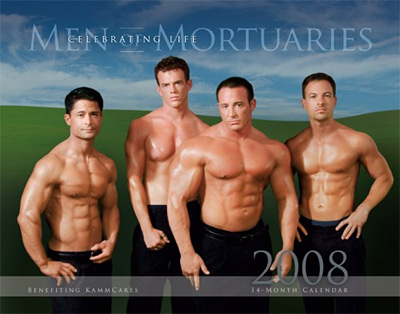Men of Mortuaries – The Calendar of Sexy Undertakers

At SocImages, illness Gwen describes ways in which morticians/funeral directors have sought to remove some of the stigmas associated with their profession:
In my Intro to Soc course I assign K.R. Thompson’s article “Handling the Stigma of Handling the Dead: Morticians and Funeral Directors” (Deviant Behavior 1991, v. 12, p. 403-429). Thompson looked at how those involved in preparing the dead for burial and planning funerals try to manage the negative perceptions they suspect much of the public has of them. Language was a major way they tried to do this–redefining themselves as “funeral directors” rather than “morticians” or “undertakers,” referring to dead people as “the deceased” rather than “the body” or “the corpse,” “casket” rather than “coffin,” and so on. The point was to try to reduce the association with death–to never blatantly refer to death at all.
They also tried to avoid what they felt were stereotypes of funeral directors. Some mentioned trying not to wear black suits, and one man went so far as to keep hand warmers in his pockets so his hands would be warm when he shook family members’ hands–a reaction to what he said was a belief that funeral directors have cold, clammy hands. Others lived in a different town than where they worked and tried to keep their careers secret.
In 2007, California-based funeral director Kenneth McKenzie went one step further to battle the stereotype of the gaunt, morbid mortician by releasing the “Men of Mortuaries” calendar. According to an Obit Magazine article about the calendar, the hundreds of applicants for the 2008 calendar were narrowed down by a mixed-race panel that included a gay older man, a gay young man, a straight older man, a straight younger man, a young straight woman and an older straight woman “to hear all voices.” McKenzie sold 20,000 calendars in 2008, and proceeds went to an organization McKenzie started to support women who, like his sister, were undergoing breast cancer treatment.
On a (kinda) related note:
- Calendario Romano (sexy Vatican priests!)
- Dieux du Stade (the infamous calendars of the domestic French rugby team)












